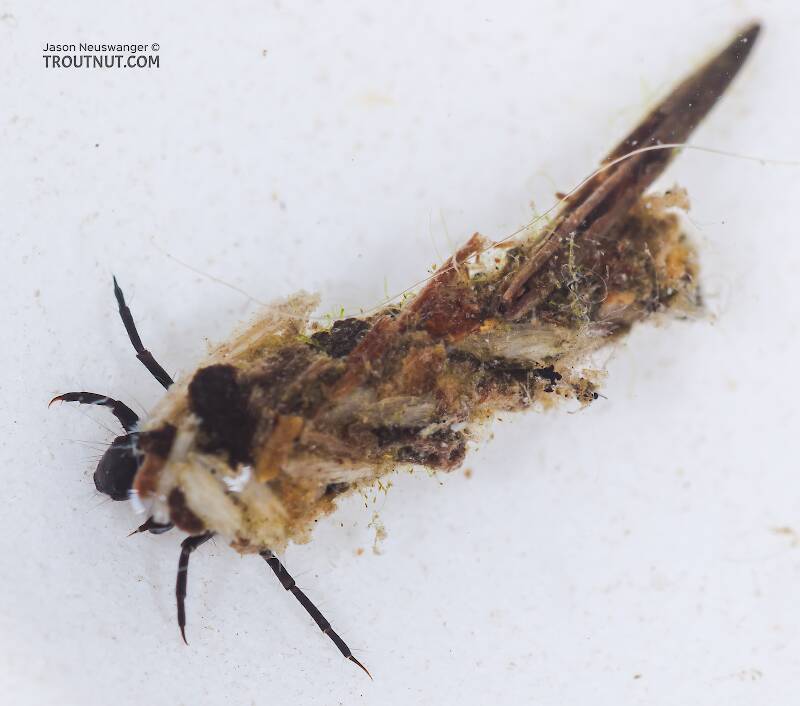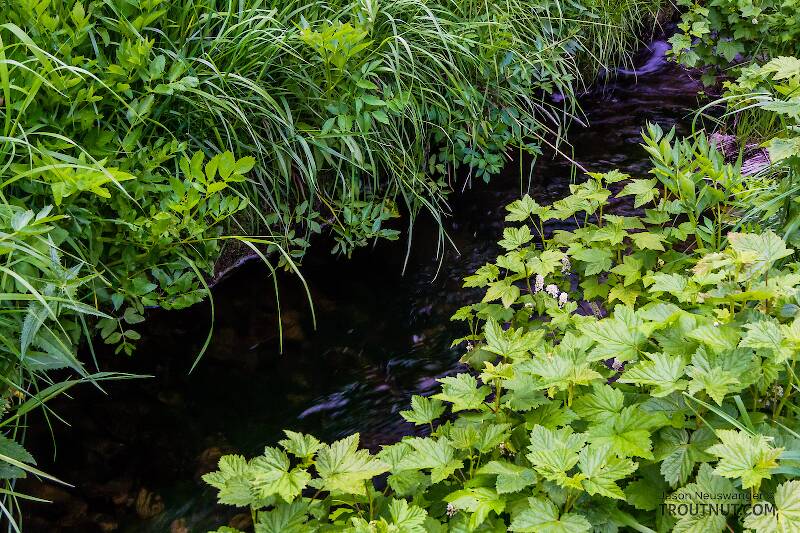
Blue-winged Olives
Baetis
Tiny Baetis mayflies are perhaps the most commonly encountered and imitated by anglers on all American trout streams due to their great abundance, widespread distribution, and trout-friendly emergence habits.
Featured on the forum

This seems to be a young larva of Limnephilus. Although not clear in the picture, several ventral abdominal segments have chloride epithelia.

Troutnut is a project started in 2003 by salmonid ecologist Jason "Troutnut" Neuswanger to help anglers and
fly tyers unabashedly embrace the entomological side of the sport. Learn more about Troutnut or
support the project for an enhanced experience here.
Troutnut on Sep 1, 2006September 1st, 2006, 5:41 am EDT
The other day I was fishing to a pool full of picky trout below a waterfall. There were NO bugs coming off, or so it seemed, and I'm better at spotting bugs than at most other things. But several trout were rising frequently. None were steadily sipping from the same feeding lane; instead, once or twice a minute a trout would hit the surface hard, often coming half-way out of the water vertically.
I tried a variety of dry flies and emergers without any luck. I didn't get so much as a look. At least the trout in the other pools on the river had the courtesy to come up where I could see them to refuse my fly. These fellows waved it off from a distance.
So, what were the trout rising to?
My guess is that they were eating drowned terrestrials. They were below a major waterfall in this forest stream, and above the falls there's a 50-yard-long, tall, overhanging gorge. It seems a lot of bugs could fall in the river there. Normally rises to ants or beetles are more subtle, which had me puzzled. But normal ants and beetles are trapped in/on the surface film. I'm thinking maybe the waterfall dunked them all below, but they floated up, so they were trapped entirely below the film like nymphs about to emerge. And maybe the trout seeing in that position were triggered to respond as if they were emergers, which explains the violent rise forms.
Or maybe, since there were so many other trout in the pool, they were taking the insects fast just because it was a race to beat the others.
Unfortunately I didn't get to test my idea, because I discovered there that I have lost the box with all the ants and beetles I tied last month.
So, what do you think they were taking?
I tried a variety of dry flies and emergers without any luck. I didn't get so much as a look. At least the trout in the other pools on the river had the courtesy to come up where I could see them to refuse my fly. These fellows waved it off from a distance.
So, what were the trout rising to?
My guess is that they were eating drowned terrestrials. They were below a major waterfall in this forest stream, and above the falls there's a 50-yard-long, tall, overhanging gorge. It seems a lot of bugs could fall in the river there. Normally rises to ants or beetles are more subtle, which had me puzzled. But normal ants and beetles are trapped in/on the surface film. I'm thinking maybe the waterfall dunked them all below, but they floated up, so they were trapped entirely below the film like nymphs about to emerge. And maybe the trout seeing in that position were triggered to respond as if they were emergers, which explains the violent rise forms.
Or maybe, since there were so many other trout in the pool, they were taking the insects fast just because it was a race to beat the others.
Unfortunately I didn't get to test my idea, because I discovered there that I have lost the box with all the ants and beetles I tied last month.
So, what do you think they were taking?
Jason Neuswanger, Ph.D.
Troutnut and salmonid ecologist
Troutnut and salmonid ecologist
Fishingguru on Sep 2, 2006September 2nd, 2006, 3:52 am EDT
I have encountered similar situations on my home waters in PA and like you was totally baffeled untill I spoiled the waters by wading into the site with a net. Didn't find any bugs, emergers, land insects, but what I did see were small baitfish scurrying about. After leaving the area and resting it for a while, I tied on a small,#12 6xlong streamer imitation, cast it upstream and stripped it as it floated through the riff. Talk about violent takes!!!
Lav
Quick Reply
Related Discussions
Topic
Replies
Last Reply
0
Apr 29, 2015
by Wbranch
by Wbranch
4
Jan 19, 2015
by Kschaefer3
by Kschaefer3
2
May 22, 2009
by Konchu
by Konchu


